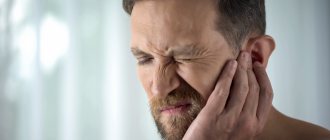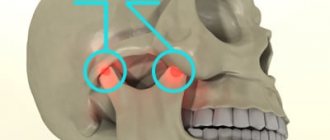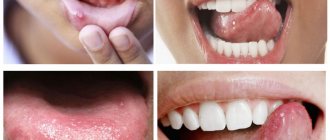Ear pain - mild or intense, shooting or aching - is a symptom that can indicate both a disease of the hearing organ and pathological processes occurring in nearby organs and tissues. According to statistics, otitis media is the most common cause of ear pain. However, the diversity of its forms and many other diseases with similar symptoms require accurate diagnosis and different treatment approaches. To establish the true causes of ear pain, it is necessary to be examined by an otolaryngologist, and sometimes by a neurologist, dentist, and even a cardiologist.
At CELT you can consult an otorhinolaryngologist.
- Initial consultation – 3,000
- Repeated consultation – 2,000
Make an appointment
Otitis externa
Most often, inflammation of the outer ear is bacterial in nature.
The causes of infection may be:
- trauma to the external auditory canal, for example, from a sharp or blunt object, or from a hearing aid;
- skin defects due to eczema, psoriasis, diabetes and other diseases;
- too thorough removal of earwax, which creates an acidic environment that prevents the growth of microbes;
- frequent entry of water into the outer ear (“swimmer’s disease”).
Symptoms of external otitis:
- acute ear pain, aggravated by pressing on the tragus or pulling the earlobe;
- possible itching and a feeling of “stuffiness” in the ear;
- discharge of a purulent or bloody nature, sometimes having an unpleasant odor;
- examination reveals swelling and hyperemia of the external auditory canal;
- possible hearing loss;
- enlargement and tenderness of the lymph nodes in the neck and behind the ear on the affected side.
The course of the disease may be complicated by a perforation of the eardrum, which cannot be determined without a visit to an ENT specialist.
External otitis of fungal origin is a common phenomenon, usually occurring in patients with low immune status or due to long-term use of antibacterial drops. It is characterized by severe itching, the formation of crusts, profuse thick discharge and the absence of a therapeutic effect from the use of antibiotics.
Separately, it is worth noting the localization of a boil on the skin of the external auditory canal or inflammation of the atheroma. The clinical picture is similar to otitis externa, but upon examination there is a more localized focus of inflammation with an opening from which pus and blood can be discharged.
Reasons for the development of atheroma
Atheroma develops in those places where there is an accumulation of a large number of sebaceous glands - in the area around the nose, on the eyelids, neck, scalp, chest, back and earlobe. Atheroma behind the ear is the most common of all types of atheroma, and, as a rule, affects both men and women equally.
The occurrence of atheroma of the earlobe is characterized by an unpredictable course and frequency of occurrence due to constant rubbing of the tumor with foreign objects - various hats, scarves, headphones, collars of shirts and blouses. In medical practice, cases of degeneration of a benign tumor into a malignant one are described, which occur in cases where proper surgical treatment is not carried out.
Otitis media
The middle ear communicates with the nasopharynx through the Eustachian tube, through which infection can penetrate from the upper respiratory tract due to acute respiratory viral infections, influenza, sore throat, rhinitis, sinusitis and other diseases. Children are especially often affected because their Eustachian tube is short and wide, which makes it easier for infection to enter. The process can be one- or two-way.
Symptoms of acute otitis media:
- pain in the ear from moderate to severe, pulsating in nature (pain does not depend on pulling the lobe or pressing on the ear canal);
- increased body temperature;
- possible noise in the ear, dizziness, decreased hearing acuity;
- the presence of discharge (mucous, purulent, bloody) indicates a perforation of the eardrum.
With an aggressive course of the inflammatory process and the absence of adequate therapy, otitis media is fraught with such serious complications as meningitis, sepsis, intracranial abscess formation, and deafness.
Treatment and prevention of atheroma
Treatment of atheroma is predominantly surgical, with removal of the cavity along with its contents. To do this, a small skin incision is made on the body, through which access to the atheroma is provided. After removing the contents, the cavity is washed, and if necessary, a turunda is inserted for several days to facilitate the release of blood, pus and fat.
The operation is performed not in a hospital setting, but on an outpatient basis. Local anesthesia is used for pain relief. For small atheromas, sutures are not applied, since the skin incision heals on its own after 5-6 days. For large atheromas, cosmetic sutures are applied, which are regularly processed after 1-2 days. The operation itself is painless for the patient, but the danger is that without eliminating the causes that caused the appearance of atheroma, there is a high probability of relapses (almost 50% of all cases). That is why it is so important not only to eliminate the cause of atheroma, but also to take measures to prevent the disease. These include personal hygiene measures and early consultation with a doctor. It is not recommended to treat atheroma on your own.
Inflammation of the inner ear (labyrinthitis)
The labyrinth is an organ of hearing and balance, is richly innervated and includes auditory and kinetic receptors, so its inflammation causes:
- severe ear pain and headaches;
- a sharp decrease in hearing, the appearance of noise, crackling, squeaking in the ear;
- dizziness, nausea, loss of orientation in space, horizontal nystagmus.
Labyrinthitis occurs as a result of the penetration of infection in various ways from different parts and cavities of the body:
- from the middle ear with untreated or advanced otitis media;
- with infected meninges during meningitis;
- with blood for diseases such as syphilis, tuberculosis, herpes;
- damage to the temporal region, the organ of hearing with disruption of the integrity of cells and blood vessels.
The disease requires immediate medical attention.
Eustachite
Eustachitis is an inflammation of the canal connecting the middle ear to the nasopharynx. The degree of pain varies. Characteristic features are:
- feeling of stuffiness in the ear;
- noise and crackling in the ear, the patient hears his voice as too loud with a weakened perception of extraneous sounds;
- sensation of water pouring into the ear.
In the absence of timely treatment, eustachitis becomes chronic, causing chronic exudative otitis media.
Ear pain of non-infectious origin
Ear tumors
Neoplasms are most often localized in the outer and middle sections; tumors of the labyrinth are an extremely rare phenomenon. Malignant formations of the outer ear are accompanied by severe pain: the pain is burning and radiates to the temple. Possible bleeding; When the ear canal is obstructed, conductive hearing loss develops. If the middle section is affected, the symptoms are similar to otitis media; a high degree of hearing loss and intense pain, increasing in the evening, should alert you. When the process spreads, symptoms of damage to neighboring structures arise: loss of orientation in space, paresis of the facial nerve, trigeminal neuralgia.
Ear injuries
- Mechanical injuries. The auricle most often suffers with the formation of lacerations and damage to cartilage. Blunt trauma to the ear usually results in a hematoma. As a result of trauma to the ear canal, the ear hurts greatly, there is a feeling of stuffiness, and bleeding is possible. Such symptoms are an indication to consult a doctor, since rupture of the eardrum and fractures of the skull bones are possible.
- Barotrauma is caused by a difference in pressure in the external environment and the cavity of the middle ear, for example, during a sharp loud sound (explosion), take-off/landing of an airplane, deep-sea immersion (diving), climbing a mountain. As a result, the eardrum is pulled inward, which is accompanied by pain, noise or ringing, and congestion in the ears. The opposite situation is also possible, when a decrease in atmospheric pressure causes the membrane to bulge outward. As a rule, unpleasant sensations go away on their own, however, if sharp pain is noted, it makes sense to check the integrity of the tympanic membrane when examined by a doctor.
- Entry of a foreign body in the form of small objects or insects causes swelling of the skin of the ear canal, itching, pain, and sometimes hearing loss. Attempting to remove a foreign object yourself can damage the eardrum.
- With burns and frostbite of the ears, **pain // of varying intensity is observed, depending on the degree of damage.
- Conventionally, ear injuries include the formation of wax plugs, which irritate the skin of the ear canal, causing discomfort and tinnitus. Removal should be carried out by an otolaryngologist.
Symptoms and signs of atheroma
Many patients, having atheromas behind the ears, do not even pay attention to them. However, sometimes atheromas become a serious concern.
It is worth paying attention to the following signs indicating the need to seek medical help:
- There is a small round ball under the skin;
- There is redness, swelling, thickening;
- There are signs of inflammation and infection;
- On the surface of the atheroma there is a small pinhole closed with a black plug;
- It is possible to extract thick yellow contents with an unpleasant odor from the atheroma.
You should consult a doctor immediately if the atheroma:
- Suddenly it began to grow quickly;
- Suddenly burst;
- Inflamed;
- It became sharply painful.
Ear pain due to diseases of other organs
- Mastoiditis - inflammation of the mastoid process - causes intense throbbing pain in the ear, swelling of the tissue behind the auricle, hearing loss, and hyperthermia.
- With arthrosis and arthritis of the temporomandibular joint, the patient is bothered by shooting pains in the ear, which intensify when chewing, a crunching sound in the temple area, and over time, hearing impairment and malocclusion are possible.
- Mumps is an inflammation of the salivary gland located in front of the auricle, accompanied by acute pain in the ear, aggravated by swallowing and chewing, and swelling of the tissues.
- Inflammation of the parotid lymph nodes (lymphadenitis) develops when infection penetrates into them from diseased teeth or from other foci of inflammation.
- Inflammatory diseases of the nasopharynx and sinuses, malignant processes in the larynx and oral cavity are often accompanied by pain in the ear when swallowing.
- Caries, pulpitis. Since the organ of hearing, like the teeth, is innervated by the branches of the trigeminal nerve, damage to the teeth and jaw may be accompanied by pain in the ear area.
- An atypical form of heart attack, when the patient’s only subjective complaint is pain in the ear.
Advantages of laser removal of atheroma behind the ear:
- Speed (removal is possible on the day of treatment in just 15-20 minutes);
- Atheromas of any size and in any condition can be removed (even festering atheromas can be removed, since the laser has a sterilizing effect on tissue);
- Bloodlessness (the laser seals the vessels that feed atheromas and removal takes place in a dry field);
- Fast recovery;
- Almost complete absence of relapses and complications in the postoperative period.
If you have atheroma, we suggest seeking help from laser medicine specialists at the ATLANTIC Laser Surgery Center.
Diagnostics
The diagnosis and treatment of pathologies associated with this symptom is carried out by an ENT doctor (otorhinolaryngologist) or an audiologist (a narrower specialty in otorhinolaryngology). During the appointment, the specialist talks with the patient, examines him, conducts the necessary examination, and establishes a diagnosis.
The multidisciplinary CELT clinic employs experienced, highly qualified otolaryngologists. Rich clinical experience helps them make the correct diagnosis in the most difficult cases.
Our doctors
Debryansky Vladimir Alekseevich
Doctor - otorhinolaryngologist, doctor of the highest category
33 years of experience
Make an appointment
Zharova Galina Gennadievna
Doctor - otorhinolaryngologist, member of the European Society of Rhinologists, doctor of the highest category
Experience 39 years
Make an appointment
Gogolev Vasily Gennadievich
Doctor - otorhinolaryngologist
19 years of experience
Make an appointment
Treatment
Treatment of inflammatory ear diseases includes:
- antibacterial, antiviral agents of local and general action;
- antipyretics, analgesics;
- physiotherapy;
- in some cases - surgical intervention.
Treatment must be based on accurate diagnosis, which is impossible outside a specialized clinic. The high professionalism of CELT specialists allows us to identify various diseases of the hearing organ and choose the most effective means of solving the problem.
Make an appointment through the application or by calling +7 +7 We work every day:
- Monday—Friday: 8.00—20.00
- Saturday: 8.00–18.00
- Sunday is a day off
The nearest metro and MCC stations to the clinic:
- Highway of Enthusiasts or Perovo
- Partisan
- Enthusiast Highway
Driving directions
What does atheroma behind the ear look like?
The reasons for the development of atheroma include the following factors:
- Disturbance of metabolic processes in the body.
- Harmful factors of external and internal ecology.
- Excessive sweating (hyperhidrosis).
- Diseases of the endocrine system and hormonal imbalance.
- Increased production of sebum by the glands and oily skin.
- Infection of the sebaceous gland duct (during ear piercing, for example).
- Presence of acne and seborrhea of the scalp.
Factors that can trigger the appearance of atheroma include improper and insufficient hygienic care and hypothermia of the body.











